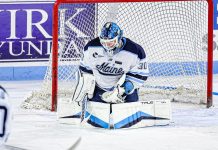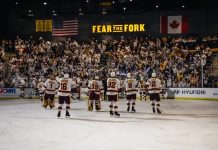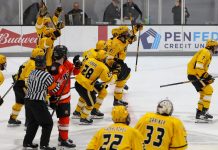
Each week during the season, we look at the big events and big games around Division I men’s college hockey in Tuesday Morning Quarterback.
PAULA: Well, Dan, here we are for the last TMQ of the season, and the logical place to begin is with the regional action we just witnessed. Congratulations to Boston University, Denver, Penn State and Western Michigan for playing their way into the Frozen Four.
There is so much we can talk about here in terms of who won, who lost and why, but I want to start with the winners. Both Denver and Boston University are making repeat appearances, with the Pioneers defending their championship in their fourth consecutive trip to Frozen Four and the Terriers seeking their first national title since 2009 in their third straight Frozen Four appearance. The ability to maintain that kind of excellence is extraordinary.
We know that repeat Frozen Four appearances – whether consecutive or recent – teaches players and even coaches in programs what it takes to get the chance to reach the FF. This year, both Penn State and Western Michigan are making their first Frozen Four appearances, and it is for certain that each program will benefit from going no matter the outcome of the games.
Both the Broncos and the Nittany Lions have stories that are new to national audiences. For Western Michigan, this is the fourth straight year of participation in the NCAA tourney and the Broncos won their first-ever NCHC title. The Broncos are the only team in the field that finished first in their conference and won their conference playoff championship.
Penn State’s story is kind of nuts. The Nittany Lions finished fifth in the Big Ten and clawed their way into an at-large bid by plowing through B1G competition in the second half. Penn State didn’t win a Big Ten game until Jan. 3, and after that, they were nearly unstoppable – 15 of their 22 overall wins coming in the second half of the season, including playoff hockey.
What are your thoughts on this field? What are your thoughts on how they got here?
DAN: The word “parity” is way overused in college hockey these days, but this past weekend proved that point about the conversation about bracket makeup and construction. We spent four days extolling the clean and even construction of a field selected by mathematical algorithm and placed into the four-team regional by the Selection Committee because the field was more cleanly aligned than previous years. More than ever, we all knew about the possibility of a pared-down tournament where no No. 1 seed had an easy path to St. Louis, and we especially knew about the matchup pitfalls facing each one of the 16 teams that qualified. I know I spent the four days prior to Thursday talking about how I knew no No, 1 seeds were safe, at least.
One week later, we’re sitting here talking about a Frozen Four with exactly one No. 1 seed advancing out of its regional. Two of the top seeds lost in regionals where they had a geographical advantage, and one lost in the first round. We watched Cornell come within an overtime goal of sending Mike Schafer to a Frozen Four for his final coaching game, and Bentley dragged Boston College through 58 minutes of 1-1 hockey before the Eagles escaped to play on Sunday. Once they got there, they ran into Denver, a team that I constantly viewed as a flawed team. I remember watching some of those weekends and wondering if Denver even belonged in the field outside of its perceived conference strength, and I just kept saying that the defending national champion wasn’t playing the same game as last year – not that it’s fair to compare a team to its previous roster that won a national championship. I saw Boston College as this megalith – admittedly from talking to players and folks through my work – but like the Death Star, that one little exhaust hole made certain types of games fatal. Along came Denver and blammo – the Pios used the Force to fire right into that pipe.
And then there’s Maine, which lost to Penn State. I’m sure folks will immediately point to the sublimated home ice advantage or disadvantage associated with playing at a host site, but let’s just call it what it is – Penn State is just plain good.
For the first time, I found myself unable to find any one clear-cut reason why teams lost, which I guess boiled down to this statement: this tournament was loaded with good teams, and good teams lost to better teams on that day. Maybe Maine would’ve beaten Penn State in Alfond, and maybe Michigan State wouldn’t have lost to Cornell in East Lansing. But ifs and buts were candy and nuts, we’d all have a Merry Christmas. In the current condition, Penn State, on that day, was better, and so was Cornell.
Also, for what it’s worth, Cornell is the same distance from Allentown as Penn State. Aside from it being in Pennsylvania, where Penn State is huge, that’s always something that made me smile.
Of course, there’s also Western Michigan, the lowest-seeded No. 1 seed and the last one standing.
I’ll eventually come back to the site selection because that’s a larger issue, but let’s start breaking down the four teams that are heading to St. Louis… what sticks out about how they each play the game, and are we headed for an equally chaotic Frozen Four?
PAULA: I’m not sure what you mean by “chaos” when you ask about its possibilty in the Frozen Four. At this point, every team that’s going deserves to be there. Each of those teams played its way through a very tough field, no matter where they played. Teams advanced because they’re good. Period. The end.
And so if you’re asking whether there is a possibility of an upset in St. Louis, that would depend also on the definition of the word “upset.” The top-seeded team in this field, Western Michigan, has the exact same amount of Frozen Four experience as the lowest seed, Penn State.
The difference, for me, comes down to experience. Every bookie in the country should have Denver as the odds-on favorite to win with Boston University losing to the Pioneers in the championship game.
That’s what should happen. Will it? Will the Pioneers get past the Broncos and the Terriers down the Nittany Lions? The cliches about one-and-done hockey apply, but only in moderation. That experience of having been there will mean a lot. The Pioneers know what it takes to win. The Terriers know how it feels to be eliminated. Neither the Broncos nor Nittany Lions know either of those things.
But both Western Michigan and Penn State know that everyone is counting them out, and that is huge, additional motivation.
How each team advanced to the Frozen Four matters, too. Denver didn’t just beat Boston College. Denver beat a BC team that was flying from the start. The Eagles outshot the Pioneers 11-5 in the first period of that regional final and 15-2 in the third period, and Denver outscored BC in both of those stanzas. Matt Davis was outstanding in that game, making allowing one goals with 35 saves against a team that scored more than three per contest on average.
In their 8-3 win over Ohio State, Boston University scored five third-period goals against a team that has dominated third periods for most of the season. In their 3-2 OT win over Cornell, the Terriers had to outlast a team that was playing its best hockey of the year and doing everything it could to extend the season for its beloved retiring coach. That may have been the best game of the entire tournament so far, for what it’s worth.
In their first game, the Broncos found a way to get past Minnesota State in double overtime by never taking their feet (hooves?) off the gas, outshooting the Mavericks in every period of that contest. In their win over Massachusetts, the Broncos used their power play – sixth in the country – to come from behind.
As for the Nittany Lions, there was never any doubt in their game against Maine – not from the five-minute mark in the first period, anyway. At 4:08 in the first period of that game, Maine’s Bodie Nobes took advantage of a rare mistake by Penn State’s Arsenii Sergeev, catching the netminder out of position for the first goal of the game. But when JJ Wiebusch answered less than a minute later, the Nittany Lions settled in, played their game and advanced. In their 3-2 win over Connecticut, the Nittany Lions looked outmatched in stretches but Sergeev was amazing and when the opportunity presented itself late in OT, Matt DiMarsico scored a pretty, clean, well-executed goal from Charlie Cerrato. The Nittany Lions didn’t just outlast the Huskies in the game – in spite of being uncharacteristically outshot 28-13 in the third period and OT – they out-waited them, too.
To circle back to your question about chaos, I don’t know what will happen in the semifinals in St. Louis, but I do know that each team has its own gifts. My head says that experience will out. My heart is hoping for a little chaos.
DAN: I’m just looking forwrad to seeing which teams develop the next phase of a championship pedigree.
I’ve retold this story a few times, but I remember watching an old playoff VHS tape – that’s how we used to watch movies and YouTube clips in the old days for you whippersnappers – from the NHL that featured a story about the Islanders in the 1980s. They’d beaten the Edmonton Oilers for the last of their four straight Stanley Cup wins, and Wayne Gretzky talked about how he walked by the locker room in the aftermath of his loss. What he saw wasn’t a team going crazy under champagne bottles, though he mentioned how the Islanders were still celebrating. What he instead witnessed was a team so beaten up that they were almost exhausted by getting to that point. At that moment, he realized what it would take to win a championship.
To me, that’s what BU’s been going through. The Terriers really took their lumps over the course of the year, and last year’s loss in the national semifinal rang through my ears when they beat Cornell in overtime. They just looked like a team more destined and more driven to win that game – and that’s not a knock against Cornell. Now seeing how Mikhail Yegorov plays against Penn State, I’m curious if Penn State understands what it’s going to take to win this level, even if they’ve been playing great. Again, not a knock. We’ll find out.
On the other side, we’ll get to see that from Western Michigan against Denver in a rematch from their NCHC championship game.
Of course, the debate about which team has an advantage is the primary conversation, but I’m hopeful that these four teams will drive some good attendance and solid games in St. Louis. The Regionals were largely great, but I still felt like the bulk of social media hunted for a good reason to bash neutral sites. Pictures from the early game in Manchester didn’t do the crowd justice after people arrived throughout the first period, and I thought the regional did a good job – not great, but good – at housing the four teams. As for the seeding and the whole host conversation, we could have that conversation until we’re all out of breath.
For what it’s worth, over 7,000 people attended Manchester’s first round. About 7,000 attended Toledo. 7,300 went to Allentown, and Fargo’s 5,000-seat arena was a near-sellout. Numbers naturally went down for the Regional finals, but I think this year was just fine on neutral site regionals, even in Allentown, where I know Penn State was a mitigating factor.
The ice surface, on the other hand, is a different story. What I don’t think people understand is how every ice surface in the Frozen Four is, for lack of a better term, temporary. Every rink – even the permanent surfaces – are thawed and removed to paint NCAA logos, so there are going to be air bubbles and pockets of bad ice on rinks that aren’t constantly resurfaced and practiced throughout the year. I’m not sure if there’s a solution there.
PAULA: But in the end, didn’t each team in a given game play on the same ice? Yes, ice surface can be problematic, but the surfaces didn’t decide outcomes of games.
The solution, Dan, is to score more goals.
At this point in the season, I get tired of hearing about alleged (or even real) home ice advantages, officiating, and all of the other factors that folks claim impacted the loss of their favorite team.
In the end, teams that outplay their opponents win. It doesn’t matter if that outplaying is all game long or limited to a finite situation. The team that finds a way to win is the team that deserves to win.
Like you, I hope the Frozen Four is well attended in St. Louis. I am not sure what it’s like now, but in the years previous to COVID, there were scores of college hockey fans that attended the FF every year regardless of field or venue. I saw some evidence of that in Tampa in 2023, the last time I was able to cover the event. I hope that still holds true.
I do want to pivot away from the Frozen Four and wrap up my last segment here mentioning a few other things.
First, I want one last shout out to three legendary college hockey coaches who are retiring: Bob Daniels, Jeff Jackson, Brian Riley and Mike Schafer. Among them, the three represent 109 years of head coaching experience at the Division I level and have 1,911 wins, collectively. Each has helped to shape the game as we know it today.
Second, I want to go on record as saying that I think Denver’s Zeev Buium will win this year’s Hobey Baker award and my prediction for the Hobey Hat Trick are Buium, Penn State’s Aiden Fink and Michigan State’s Isaac Howard. Also, I think Alex Tracy will win the Richter Award.
(Fear not, fans of other candidates. I’m neither a Hobey voter this year nor very good at predicting much of anything.)
And last, I can’t put a cap on this season without mentioning the sheer number of players who have entered the transfer portal. By my count late on Monday night, there were 174.
I’m not surprised by any of the players who have signed professional contracts early (not surprised yet, that is), but some of the players entering the portal have surprised me. Topping that list is forward Sacha Boisvert, the first-round draft pick of the Chicago Blackhawks who just completed his first season with North Dakota. Also interesting: there are a dozen (I think) players from Northern Michigan who have entered the portal. That many players from one team is a whole other column right there.
As we pack up TMQ for the season, Dan, what final thoughts do you have?
DAN: I suppose that it’s probably best to end the year on a high note because none of the complaining about ice conditions or transfer portals or NIL deals or anything related to on-ice or off-ice debates changes the 50,000-foot viewpoint of a sport. I’m prone to romanticizing sports a bit in my life, but I wholly believe in their ability to help escape from the dangers or downfalls associated with day-to-day activities.
I don’t mean anything hyperbolic about world events, either. I literally view college hockey with an escapist mentality after I sign out of work, and my conversations with people within the game take to the happy place in life (cue Happy Gilmore’s grandma hitting the slot machine with regularity). It’s still cool to get that feeling and transformation whenever I walk into an arena, and this year, especially, gave it to me because I knew I was likely seeing a hard-fought game between two teams. Even the coaches and players seemed to be in a much more fulfilled place within the sport.
I hope that’s something we can all hold in the aftermath of crowning a national champion. The offseason is going to bring us so much change – Mike Schafer, Brian Riley, Jeff Jackson and Bob Daniels, for starters – and we’re going to see new coaches and players in new spots. Some guys are heading right into the thick of Stanley Cup playoff races.
Whatever happens, I just hope we can all come back in October and share the joy of a new season. New high fives. New banners. New personnel. Same laundry. And the same people all coming back to the same arenas to share a beer (legally, of course), a hot dog or an order of nachos, and the best game on Earth.
And, with any luck, you and I can come back and do this all over again, as well.
Best of summer to you and yours!


